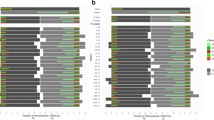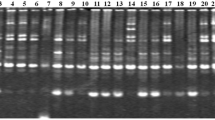Abstract
We tested the application of RAPD technology for identification of hybrid genomes originated from a maternal clone of Lolium perenne L. (2n = 2x = 14) bearing cytoplasmic male sterility, which was pollinated separately by five clones of Festuca arundinacea Schreb. cv. Barocco (2n = 6x = 42). Six classes of RAPD markers were recognized, specific to: 1) Festuca genome and inherited into F1 hybrid genomes, 2) Lolium genome inherited into F1 hybrid genomes, 3) Lolium-specific bands not found in F1 progeny, 4) Festuca-specific bands not found in F1 progeny, 5) new bands found only in F1 hybrid profiles, 6) bands common to all parental and F1 hybrid genotypes. RAPD data were shown to have full potential a) to serve as an unequivocal proof of genome recombination in perennial ryegrass × tall fescue hybrids, b) to identify hybrid genomes, c) to reveal phenetic relationships of the accessions from crossing families, d) to enhance, by fingerprinting, the selection of superior hybrid material for further breeding. RAPD data were found to be consistent with the festucoid phenotype of F1 hybrids.
Similar content being viewed by others
References
Badoux, S.: La transmission des caractères de Lolium multiflorum et Festuca arundinacea à leurs hybrides.-Res. Agron. Suisse 4: 341–350, 1973.
Caetano-Anollés, G., Bassam, B., Gresshoff, P.M.: DNA amplification fingerprinting using very short arbitrary oligonucleotide primers.-Biotechnology 9: 553–557, 1991.
Ceccarelli, M., Falistocco, E., Cionini, P.G.: Variation of genome size and organization within hexaploid Festuca arundinacea.-Theor. appl. Genet. 83: 273–278, 1992.
Ceccarelli, M., Minelli, S., Falcinelli, M., Cionini, P.G.: Genome size and plant development in hexaploid Festuca arundinacea.-Heredity 71: 555–560, 1993.
Cesarone, C.F., Bolognesi, C., Santi, L.: Improved microfluorometric DNA determination in biological material using 33258 Hocchest.-Anal. Biochem. 100: 188–197, 1979.
Chen, C., Sleper, D.A., West, C.P.: RFLP and cytogenetic analyses of hybrids between Festuca mairei and Lolium perenne.-Crop Sci. 35: 720–725, 1995.
Eizenga, G.C., Buckner, R.C.: Cytological and isozyme evaluation of tall fescue × Italian ryegrass hybrids.-Plant Breed. 97: 340–344, 1986.
Eizenga, G.C., Burrus, P.B., Pedersen, J.F., Cornelius, P.L.: Meiotic stability of 56-chromosome tall fescue hybrid derivatives.-Crop Sci. 31: 1532–1535, 1991.
Gymer, P.T., Whittington, W.J.: Hybrids between Lolium perenne L. and Festuca pratensis Huds. I. Crossing and incompatibility.-New Phytol. 72: 411–424, 1974.
Humphreys, M.W.: The controlled introgression of Festuca arundinacea genes into Lolium multiflorum.-Euphytica 42: 105–116, 1989.
Janeček, J.: Application of in vitro cultures in interspecific and intergeneric hybridization of Lolium and Festuca.-PhD. Thesis. Institute of Experimental Botany, Czechoslovak Acad. Sci., Prague 1984.
Jauhar, P.P.: Chromosome relationships between Lolium and Festuca (Gramineae).-Chromosoma (Berlin) 52: 103–121, 1975.
Nitzsche, W.: Deutsches Weidelgrass (Lolium perenne L.) aus Kreuzungen zwischen Wiesenschwingel (Festuca pratensis Huds.) und Welschem Weidelgrass (Lolium multiflorum Lam.).-Z. Pflanzenzücht. 1: 97–116, 1974.
Perez-Vicente, R., Petris, L., Osusky, M., Potrykus, I., Spangenberg, G.: Molecular and cytogenetic characterization of repetitive DNA sequences from Lolium and Festuca: applications in the analysis of Festulolium hybrids.-Theor. appl. Genet. 84: 145–154, 1992.
Stammers, M., Harris, J., Evans, G.M., Hayward, M.D., Forster, J.W.: Use of random PCR (RAPD) technology to analyse phylogenetic relationships in the Lolium/Festuca complex.-Heredity 74: 19–27, 1994.
Takamizo, T., Spangenberg, G., Suginoba, K., Potrykus, I.: Intergeneric somatic hybridization in Gramineae: somatic hybrid plants between tall fescue (Festuca arundinacea Schreb.) and Italian tyegrass (Lolium multiflorum Lam.).-Mol. gen. Genet. 231: 1–6, 1991.
Wang, H., Qi, M., Cutler, A.J.: A simple method of preparing plant samples for PCR.-Nucl. Acids Res. 21: 4153–4154, 1993.
Wiesner, I., Samec, P., NaŠinec, V.: Identification and relationships of cultivated accessions from Lolium-Festuca complex based on RAPD fingerprinting.-Biol. Plant. 37: 185–195, 1995.
Xu, W.W., Sleper, D.A., Chao, S.: Detection of RFLPs in perennial ryegrass, using heterologous probes from tall fescue.-Crop Sci. 32: 1366–1370, 1992.
Zwierzykowski, Z.: Hybrid of Lolium multiflorum Lam (2n=14) × Festuca arundinacea Schreb. (2n=42) and its alloploid derivatives. I. Morphology, fertility and chromosome number of F1 hybrids and C0 and C1 alloploid derivatives.-Genet. pol. 3: 259–274, 1980.
Author information
Authors and Affiliations
Rights and permissions
About this article
Cite this article
Šiffelová, G., Pavelková, M., Klabouchová, A. et al. Rapd fingerprinting of diploid Lolium perenne × hexaploid Festuca arundinacea hybrid genomes. Biologia Plantarum 40, 183–192 (1997). https://doi.org/10.1023/A:1001056201052
Issue Date:
DOI: https://doi.org/10.1023/A:1001056201052




